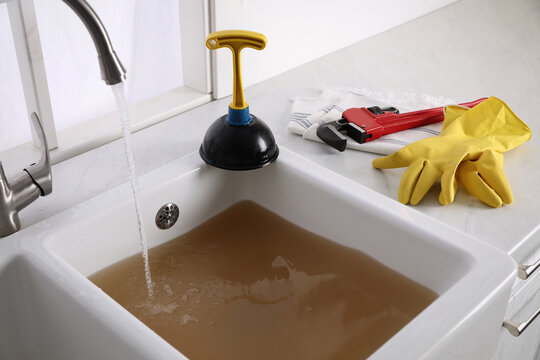Presented here underneath you can find additional great facts in relation to How to Unclog Your Sink with a Plunger.

Introduction
Correct maintenance of home drains pipes is important for stopping clogs and making sure smooth water circulation. One of the trick tools in every homeowner's toolkit is the bettor, alongside numerous drain cleaners made to take on persistent obstructions successfully. This post explores how to make use of plungers and drainpipe cleansers successfully to maintain your drains moving openly.
Area 1: Comprehending Plungers
Types of Plungers
There are several types of plungers offered, each created for various sorts of drains pipes and obstructs. One of the most usual kinds consist of mug bettors, flange plungers, and accordion plungers.
How Plungers Work
Plungers work with the concept of developing pressure and suction to dislodge clogs. When properly used over a drain, they create a vacuum cleaner that can take out debris or separate clogs.
Selecting the Right Plunger
Picking the best bettor depends upon the type of drainpipe and the nature of the obstruction. Mug bettors are suitable for sinks and bathtubs, while flange plungers are better matched for commodes because of their design.
Usual Blunders with Plungers
Avoiding these blunders makes sure effective plunging: inappropriate seal around the drain, insufficient pressure, and not clearing bordering debris.
Area 2: Utilizing Plungers Effectively
Prep work
Prior to plunging, guarantee the bettor covers the drainpipe entirely and forms a tight seal. Clear any kind of noticeable debris around the drain opening.
Strategy
Begin with mild plunging activities to build suction. Boost stress slowly, making use of a stable rhythm. Repeat as needed until the drain removes.
Repairing Tips
If diving doesn't work, try changing the seal, using oil jelly for a better seal, or using a different kind of plunger.
Section 3: Comprehending Drainpipe Cleaning Company
Sorts Of Drainpipe Cleaning Company
Drain pipes cleansers can be chemical or chemical. Chemical cleaners utilize strong chemicals to dissolve clogs, while enzymatic cleaners make use of all-natural enzymes to break down raw material.
Exactly How Drain Cleaners Job
Chemical cleansers respond with clogs to dissolve them, while chemical cleansers break down organic materials like hair and oil without hurting pipes.
Safety and security Factors to consider
Always put on handwear covers and eye protection when making use of chemical drainpipe cleaners. Make certain appropriate ventilation and comply with producer guidelines very carefully.
Eco-Friendly Alternatives
Think about making use of vinegar and baking soft drink or enzyme-based cleaners for environment-friendly choices that are more secure for pipes and the environment.
Section 4: Using Drainpipe Cleaning Company Properly
Application Techniques
Put chemical cleaners directly into the drainpipe opening. Enable them to work for the advised time before flushing with warm water. Enzymatic cleaners must rest overnight.
Preventative measures
Stay clear of mixing different kinds of cleansers, as this can generate toxic fumes. Never utilize chemical cleansers combined with a bettor, as splashing can take place.
Managing Stubborn Blockages
For relentless blockages, take into consideration using a pipes serpent or calling an expert plumbing professional to avoid damages to pipelines.
Conclusion
To conclude, recognizing how to use plungers and drainpipe cleansers properly is crucial for preserving healthy pipes systems. By choosing the right devices and methods, homeowners can deal with minor blockages and prevent significant pipes problems down the line.
How to Use a Plunger to Unclog a Drain
The humble plunger is a simple yet effective tool for breaking clogs in sinks, tubs and toilets. This handy tool is easy to use. You can make the most of its power if you understand how it works. Ready to dive in? Here’s what you need to know.
Safety First!
Never use a plunger with drain chemicals. Water will splash as you work, and the chemicals can spatter, burning skin and eyes. It’s a good idea to use rubber gloves and wear safety goggles when you work on a clog.
Choose the Right Tool for the Job
Plungers come in two different styles. Sinks, bathtubs and showers require a cup plunger. Like its name suggests, the rubber end is shaped like a cup. Use a flange plunger on toilets. These plungers have a rubber funnel extending from the cup. A plunger needs to be big enough to cover the drain.
Ready, Set, Plunge!
- Coat the rim: Coat the plunger rim with petroleum jelly. This helps make a better seal.
- Block outlets: Hold a wet rag over nearby outlets such as the overflow vent or the drain in a second sink.
- Release air: Insert the plunger at an angle into the water. Water will displace air in the cup. A water-filled cup is more forceful than one filled with air.
- Keep the plunger upright: Hold the plunger perpendicular to the drain. Use fast, forceful strokes, but make the first stroke gentle. The first stroke can create a splash if the cup still contains air. Thrust the plunger 15 to 20 times.
- Snap off the plunger: The final stroke should be a strong upward motion that ends when the plunger snaps off the drain.
- Repeat the process: you may need to repeat this sequence several times. When the water drains away, your work is done. High-five!
https://plumbernw.com/blog/how-to-use-a-plunger-to-unclog-a-drain/

I discovered that post on How to Unclog Your Sink with a Plunger when exploring the internet. Feel free to pause to promote this post if you liked it. Many thanks for being here. Return soon.
Request Service
Comments on “Master Plungers and Drain Cleaners Techniques: Specialist Tips”